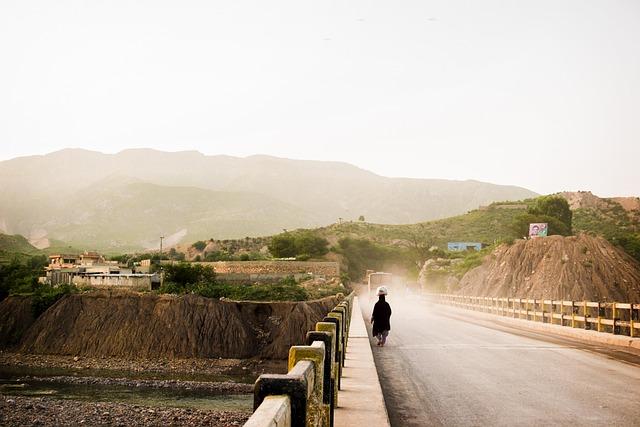In the heart of South Asia, where ancient civilizations intertwine with modern aspirations, Pakistan stands as a testament to the complex tapestry of resilience and strife. With breathtaking landscapes ranging from majestic mountains to thriving urban centers, the country is often overshadowed by challenges that threaten its stability—most notably, the persistent menace of terrorism. Yet, in the face of chaos, a profound narrative emerges. This article delves into the multi-faceted fight against terrorism in Pakistan, exploring the unwavering spirit of its people and the intricate measures taken by the state to navigate the turbulent waters of violence and unrest. From grassroots movements to decisive military campaigns, Pakistan’s journey is one of struggle and tenacity, underscoring the broader human quest for peace and security amidst the storm. Join us as we unravel the layers of resilience that define this vibrant nation and its steadfast commitment to overcome the shadows of discord.
Exploring the Historical Context of Terrorism in Pakistan
The historical roots of terrorism in Pakistan can be traced back to a complex interplay of political, social, and economic factors. Following the partition of India in 1947, Pakistan faced the daunting task of forging a national identity amidst diverse ethnic and sectarian groups. The subsequent decades were marked by political instability, military coups, and regional tensions, which not only weakened governance but also paved the way for extremist ideologies to flourish. The Soviet-Afghan War in the 1980s further exacerbated the situation as Pakistan became a frontline state in the Cold War, leading to an influx of arms and radical elements that contributed to the rise of jihadist movements within its borders.
As the new millennium approached, Pakistan found itself grappling with the consequences of earlier foreign policies that had inadvertently nurtured militant groups as proxies. The post-9/11 landscape brought a fierce backlash, with intensified violence from various terrorist factions. This chaotic environment demanded a multifaceted response from the Pakistani state, including military operations and counter-terrorism initiatives aimed at dismantling networks that had grown emboldened. Key factors in these efforts include:
- Military Operations: Significant campaigns against entrenched militant strongholds.
- Legislative Measures: Introduction of anti-terrorism laws to strengthen judicial responses.
- Community Engagement: Involving local populations in deradicalization efforts.

Understanding the Socioeconomic Impact on Communities
The socioeconomic conditions of communities in Pakistan have been significantly influenced by the ongoing battle against terrorism. Amidst volatility, various sectors have faced disruption, leading to widespread *economic instability*. As communities grapple with these challenges, the impacts are often felt in several key areas, including:
- Job Creation: Fear and uncertainty stifle business operations, hampering the ability to generate new employment opportunities.
- Education: Schools are often targets or collateral damage, leading to decreased literacy rates and disrupted education for children.
- Health Services: Resources are frequently redirected towards security measures, leaving healthcare systems strained and underfunded.
- Infrastructure: Damage to physical structures from conflicts results in higher costs and delays in rebuilding efforts.
In the face of these challenges, however, communities have exhibited incredible resilience. Initiatives that focus on *community development* and *empowerment* have emerged as vital solutions to restore stability. The need for comprehensive support mechanisms is apparent, as entrepreneurial efforts can revive economies. A focus on the following factors can promote healing and growth:
- Public-Private Partnerships: Collaborative efforts can revitalize industries and foster job creation while enhancing infrastructure.
- Community Engagement: Involving local populations in decision-making processes can bolster recovery strategies and increase ownership.
- Investment in Education: Prioritizing educational reforms will equip future generations with necessary skills, mitigating long-term socioeconomic impacts.

Integrated Strategies for Building Resilience and Security
The pursuit of stability in Pakistan’s fight against terrorism necessitates a multifaceted approach that integrates efforts across various sectors. A foundational strategy involves strengthening community engagement, encouraging grassroots participation in security initiatives, and fostering resilient social networks. By empowering local populations, authorities can cultivate a culture of vigilance and cooperation that acts as a deterrent against extremist activities. This entails:
- Promoting educational programs on peace and conflict resolution
- Establishing dialogue platforms between security forces and communities
- Enhancing local law enforcement training to recognize and counteract radicalization
In tandem with community efforts, strategic institutional reforms are pivotal in addressing the root causes of terrorism. This includes revising social policies to ensure equal access to economic opportunities, specifically targeting areas historically vulnerable to extremism. By addressing grievances and providing alternatives, the government can reduce the allure of radical ideologies. Key actions should focus on:
| Strategy | Description |
|---|---|
| Economic Development | Investment in job creation programs and vocational training |
| Healthcare Access | Improving the healthcare infrastructure in high-risk areas |
| Law Enforcement Collaboration | Strengthening partnerships between local and national forces |

Engaging Civil Society: A Crucial Component in the Fight Against Terrorism
In the intricate tapestry of combating terrorism, the involvement of civil society is not merely beneficial; it is essential. When communities are actively engaged, they can become formidable allies against extremist narratives. Activist groups and local organizations bring unique insights and resources to the table, fostering resilience and solidarity among citizens. By leveraging grassroots movements, awareness campaigns, and educational programs, we can empower individuals to reject violence and become ambassadors for peace. Some effective strategies to enhance civil society engagement include:
- Community Dialogues: Organizing forums that facilitate open discussions about the dangers of extremism.
- Educational Initiatives: Implementing programs in schools and local organizations to educate youth about tolerance and coexistence.
- Social Media Campaigns: Utilizing digital platforms to counteract radical narratives and promote positive messaging.
Moreover, a collaborative approach with the government and security agencies can amplify the effectiveness of these efforts. Establishing partnerships enables civil society groups to receive training and resources that enhance their capacity to act against terrorism. Agencies can provide valuable intelligence while respecting the autonomy of civil entities, creating a balanced ecosystem for combating extremism. To visualize the impact and interaction between these elements, the table below outlines the roles of various stakeholders in this ongoing fight:
| Stakeholder | Role | Benefits |
|---|---|---|
| Government | Policy formulation and resource allocation | Streamlined efforts and sustained support |
| Civil Society | Community engagement and awareness | Grassroots support and participation |
| Security Agencies | Intelligence gathering and monitoring | Timely intervention and risk mitigation |
The Way Forward
As we reflect on Pakistan’s ongoing battle against the insidious specter of terrorism, it becomes evident that resilience is not merely a response to chaos but a steadfast commitment to hope and renewal. The nation’s journey—marked by challenges, sacrifices, and an unwavering spirit—serves as a poignant reminder of the strength found in unity and determination. While the shadows of violence may loom large, the story of Pakistan is one of courage, adaptability, and the relentless pursuit of peace.
This struggle is not just about combating external threats; it is also about fortifying the foundations of society, fostering understanding, and building bridges that transcend divisions. As we consider the path forward, it is essential to recognize the role of every individual in this narrative, from the common citizen to policymakers, who together contribute to the tapestry of resilience that defines Pakistan.
In the face of chaos, the enduring spirit of the nation shines brightly, illuminating a pathway towards stability and prosperity. Pakistan’s fight is far from over, but with each step taken in unity, the country moves closer to a future where peace can flourish amidst the remnants of conflict. Let us remember that resilience is not the absence of struggle, but the art of rising stronger with each challenge faced. Thus, as we close this chapter, we are reminded that the story of resilience continues, guided by the hope of a safer tomorrow for all.



